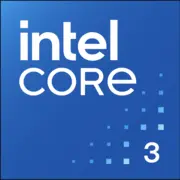Intel Core 3 100U (IPU)

The Intel Core i3 100U processor is a solid entry-level CPU for mobile platforms. With a code name of Raptor Lake and based on Intel's 7nm technology, this processor offers efficient performance for everyday computing tasks.
With a total of 6 cores and 8 threads, the Core i3 100U is capable of handling multitasking with ease, making it suitable for office work, browsing, and light content creation. The integrated Intel Graphics provide decent visuals for casual gaming and multimedia consumption, although it may not be suitable for more demanding gaming needs.
One of the key highlights of the Core i3 100U is its power efficiency, making it an excellent choice for laptops and ultrabooks where battery life is crucial. The processor is also capable of handling daily productivity tasks with ease, making it a reliable choice for students and professionals on-the-go.
Overall, the Intel Core i3 100U processor offers a good balance of performance and power efficiency for everyday computing needs. While it may not be suitable for heavy multitasking or high-end gaming, it serves as a reliable option for budget-friendly laptops and ultrabooks.
Basic
Label Name
Intel
Platform
Mobile
Launch Date
January 2024
Model Name
?
The Intel processor number is just one of several factors - along with processor brand, system configurations, and system-level benchmarks - to be considered when choosing the right processor for your computing needs.
100U
Code Name
Raptor Lake
CPU Specifications
Total Cores
?
Cores is a hardware term that describes the number of independent central processing units in a single computing component (die or chip).
6
Total Threads
?
Where applicable, Intel® Hyper-Threading Technology is only available on Performance-cores.
8
Performance-cores
2
Efficient-cores
4
Max Turbo Frequency
?
Max Turbo Frequency is the maximum single-core frequency at which the processor is capable of operating using Intel® Turbo Boost Technology and, if present, Intel® Turbo Boost Max Technology 3.0 and Intel® Thermal Velocity Boost. Frequency is typically measured in gigahertz (GHz), or billion cycles per second.
4.7 GHz
Technology
?
Lithography refers to the semiconductor technology used to manufacture an integrated circuit, and is reported in nanometer (nm), indicative of the size of features built on the semiconductor.
Intel 7
Processor Base Power
?
The time-averaged power dissipation that the processor is validated to not exceed during manufacturing while executing an Intel-specified high complexity workload at Base Frequency and at the junction temperature as specified in the Datasheet for the SKU segment and configuration.
15 W
Maximum Turbo Power
?
The maximum sustained (>1s) power dissipation of the processor as limited by current and/or temperature controls. Instantaneous power may exceed Maximum Turbo Power for short durations (<=10ms). Note: Maximum Turbo Power is configurable by system vendor and can be system specific.
55 W
Max. Operating Temperature
?
Junction Temperature is the maximum temperature allowed at the processor die.
100°C
Memory Specifications
Memory Type
?
Intel® processors come in four different types: Single Channel, Dual Channel, Triple Channel, and Flex Mode. Maximum supported memory speed may be lower when populating multiple DIMMs per channel on products that support multiple memory channels.
Up to DDR5 5200 MT/s Up to DDR4 3200 MT/s Up to LPDDR5/x 5200 MT/s Up to LPDDR4x 4267 MT/s
Max Memory Size
?
Max memory size refers to the maximum memory capacity supported by the processor.
96 GB
Memory Channels
?
The number of memory channels refers to the bandwidth operation for real world application.
2
GPU Specifications
Integrated Graphics Model
?
An integrated GPU refers to the graphics core that is integrated into the CPU processor. Leveraging the processor's powerful computational capabilities and intelligent power efficiency management, it delivers outstanding graphics performance and a smooth application experience at a lower power consumption.
Intel® Graphics
Graphics Frequency
?
Graphics max dynamic frequency refers to the maximum opportunistic graphics render clock frequency (in MHz) that can be supported using Intel® HD Graphics with Dynamic Frequency feature.
1.25 GHz
Miscellaneous
Intel Deep Learning Boost (Intel DL Boost) on CPU
?
A new set of embedded processor technologies designed to accelerate AI deep learning use cases. It extends Intel AVX-512 with a new Vector Neural Network Instruction (VNNI) that significantly increases deep learning inference performance over previous generations.
Yes
Share in social media
Or Link To Us
<a href="https://cputronic.com/en/cpu/intel-core-3-100u-ipu" target="_blank">Intel Core 3 100U (IPU)</a>